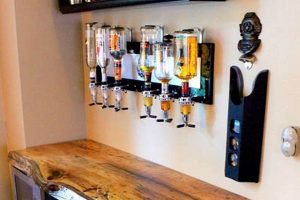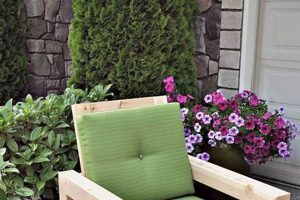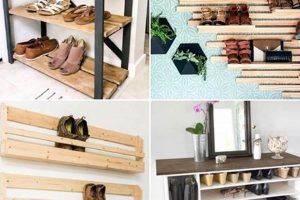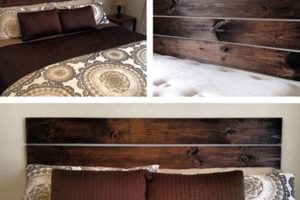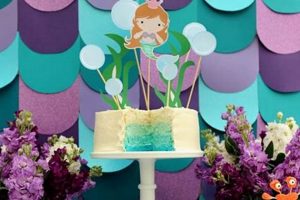The concept involves creating reflective surfaces through personal craftsmanship, diverging from commercially manufactured items. This encompasses projects ranging from embellishing existing frames to constructing entirely new looking glasses from various materials. Examples include mosaics using broken tiles, repurposing vintage window frames, and crafting sunburst designs with wooden dowels. The essence is personalization and resourcefulness in home dcor.
The application of such projects offers considerable cost savings compared to purchasing ready-made options. Furthermore, engaging in these activities fosters creativity and allows for the development of unique pieces tailored to specific aesthetic preferences and spatial requirements. Historically, crafting looking glasses has been a hallmark of skilled artisans; contemporary application democratizes this art form, enabling broader participation.
The subsequent sections of this discussion will explore various techniques, materials, and design considerations relevant to realizing personalized reflective surfaces. Practical guidance will be provided, enabling effective project planning and execution. Furthermore, safety precautions associated with cutting and handling materials will be addressed.
Guidelines for Reflective Surface Crafting
This section outlines crucial considerations to ensure optimal outcomes when engaging in personalized reflective surface projects. Adherence to these guidelines facilitates both aesthetic appeal and structural integrity.
Tip 1: Material Selection: The choice of substrate significantly impacts the final product. Consider using high-quality glass or acrylic sheets for optimal reflection and longevity. Inherent flaws in the chosen material become amplified in the finished result.
Tip 2: Precise Cutting Techniques: Accuracy is paramount when shaping the reflective material. Employ appropriate cutting tools designed for glass or acrylic, and utilize templates to ensure consistent dimensions and clean edges. Inaccurate cuts compromise the finished appearance.
Tip 3: Edge Treatment: Raw edges of glass present a safety hazard. Employ edging techniques such as grinding, sanding, or framing to eliminate sharpness. Failure to address edges can lead to injury.
Tip 4: Adhesive Selection: When adhering the reflective surface to a backing or frame, use specialized adhesives designed for this purpose. Incompatible adhesives may cause damage to the reflective coating or result in bond failure. Review manufacturer recommendations for adhesive compatibility.
Tip 5: Surface Preparation: Prior to adhering the reflective surface, thoroughly clean and degrease both the substrate and the reflective material. Contaminants can impede adhesion and compromise the visual clarity of the surface.
Tip 6: Secure Mounting: Implement robust mounting hardware appropriate for the size and weight of the completed project. Inadequate support can result in the surface detaching from the wall, posing a safety risk.
Tip 7: Design Considerations: When incorporating the reflective surface into a larger design, carefully consider its placement and orientation. Strategic placement can enhance natural light and create a sense of spaciousness.
Implementing these guidelines significantly increases the likelihood of a successful project, characterized by aesthetic appeal, structural integrity, and safety.
The following sections will address specific project examples and advanced techniques for crafting bespoke reflective surfaces.
1. Frame Material
Frame material fundamentally defines the aesthetic character and structural integrity of a handcrafted reflective surface. The selected material directly impacts the style, weight, and overall durability of the finished item. For instance, reclaimed wood imparts a rustic, vintage feel, while sleek metallic frames suggest a modern, minimalist aesthetic. The material’s inherent properties, such as moisture resistance and load-bearing capacity, dictate its suitability for specific environments and mirror sizes. Improper material selection can lead to premature degradation, structural failure, or an aesthetic mismatch within the intended space. Consider a large, heavy mirror utilizing a frame constructed from insufficiently robust material; the resulting stress could cause frame warping or complete failure, rendering the project unsafe and aesthetically compromised.
The choice of frame material also influences the construction techniques employed. Working with wood necessitates woodworking tools and joinery methods, whereas metal frames require welding or soldering skills. Material compatibility with adhesives and finishes is crucial for long-term durability and visual appeal. Furthermore, material cost and availability are practical considerations impacting project feasibility. An elaborate, hand-carved wooden frame may offer a visually stunning result but requires significant time, skill, and expense. Conversely, a simple, mass-produced metal frame offers a cost-effective and readily available alternative, albeit with a potentially less unique aesthetic.
In summary, the selection of frame material is a critical determinant of both the aesthetic outcome and the structural performance of a reflective surface. Careful consideration of material properties, construction techniques, and cost constraints is essential for realizing a successful project. A judicious choice balances aesthetic aspirations with practical considerations, resulting in a visually pleasing and durable addition to the intended environment. Neglecting this foundational element can lead to project failure and aesthetic discord, undermining the overall design intent.
2. Reflective Surface Quality
The optical characteristics of the reflective surface exert a profound influence on the utility and aesthetic value of handcrafted reflective surfaces. Selection of appropriate materials and careful handling are essential for achieving a satisfactory outcome.
- Clarity and Distortion
Surface clarity is paramount. Imperfections, scratches, or distortions diminish the reflective fidelity, rendering the surface unsuitable for accurate reflection. A mirrored surface exhibiting significant distortion compromises its function, misrepresenting the reflected image. For example, using low-grade glass with inherent waves or bubbles will result in a distorted reflection, negating the purpose of the project.
- Reflectivity and Brightness
Reflectivity quantifies the percentage of incident light reflected by the surface. Higher reflectivity results in a brighter and more vivid reflection. Surfaces with low reflectivity appear dull and lack visual impact. Silvered glass commonly exhibits high reflectivity, whereas alternative materials such as polished metal may offer vary
ing degrees of reflection depending on surface preparation and polishing techniques. - Surface Coating Integrity
Many reflective surfaces rely on a thin metallic coating to achieve their reflective properties. The integrity of this coating is critical for long-term durability. Scratches, corrosion, or delamination of the coating diminish reflectivity and compromise the aesthetic appearance of the surface. Proper handling and the application of protective coatings can extend the lifespan of the reflective surface.
- Spectral Uniformity
Ideal reflective surfaces exhibit uniform reflection across the visible spectrum. Variations in spectral reflectance can introduce color casts or alter the perceived colors of reflected objects. High-quality silvered glass typically demonstrates good spectral uniformity, whereas tinted or colored reflective materials intentionally alter the spectral composition of reflected light.
Attention to surface quality is crucial in achieving desired aesthetic effects. Selecting high-quality materials and employing appropriate handling techniques are essential for maximizing the functional and aesthetic potential of the handcrafted reflective surface. Compromising on surface quality undermines the entire project, irrespective of frame design or construction techniques. Therefore, due diligence in material selection is paramount.
3. Adhesive Compatibility
Adhesive compatibility constitutes a critical success factor in the execution of personalized reflective surface projects. The bond between the reflective element and the substrate or frame directly influences the longevity and structural integrity of the finished piece. Incompatibility between adhesive and materials frequently precipitates delamination, discoloration, or outright bond failure, resulting in aesthetic degradation and potential safety hazards. The reflective backing, typically a thin metallic layer, is particularly susceptible to chemical reactions with unsuitable adhesives. For instance, acidic adhesives can corrode the backing, leading to visible blemishes and diminished reflectivity.
The selection of an appropriate adhesive mandates careful consideration of material properties. Glass, metal, wood, and composite materials each exhibit unique surface characteristics that impact adhesive performance. Adhesives formulated for porous materials, such as wood, may not achieve a sufficient bond with non-porous surfaces like glass or metal. Conversely, adhesives designed for non-porous surfaces may lack the necessary penetration and mechanical interlocking to effectively bond with wood. Furthermore, environmental factors, such as temperature and humidity, influence adhesive performance. Adhesives designed for indoor use may degrade rapidly when exposed to outdoor conditions.
In summation, adhesive compatibility represents a fundamental aspect of reflective surface construction. Proper adhesive selection, informed by material properties and environmental considerations, is crucial for ensuring the durability, aesthetic appeal, and safety of the finished product. A failure to adequately address adhesive compatibility frequently results in project failure, necessitating costly repairs or complete reconstruction. Consequently, meticulous research and adherence to manufacturer recommendations are paramount.
4. Design Complexity
Design complexity, within the context of personalized reflective surface projects, exerts a significant influence on the feasibility, cost, and ultimate aesthetic success of the undertaking. Projects can range from simple, minimalist designs involving basic framing to intricate, multi-faceted creations incorporating mosaic patterns, complex geometric shapes, or integrated lighting systems. The level of complexity directly correlates with the required skill set, the necessary tools and materials, and the time investment. An overly ambitious design, exceeding the capabilities of the crafter or the available resources, frequently leads to project failure or a substandard outcome. Conversely, a design lacking sufficient complexity may fail to achieve the desired aesthetic impact, resulting in a visually uninspired or underwhelming piece. Consider a simple square mirror with a plain wooden frame; the design complexity is low, requiring minimal skill and resources. In contrast, imagine a large, irregularly shaped mirror incorporating hand-cut stained glass mosaic elements and integrated LED backlighting; the design complexity is substantially higher, demanding advanced skills, specialized tools, and a significant time commitment.
The practical implications of design complexity extend beyond the immediate construction process. Complex designs often require more detailed planning and prototyping to ensure accurate execution and avoid costly errors. Material waste tends to increase with design complexity due to the higher likelihood of miscalculations or cutting mistakes. Furthermore, intricate designs frequently present greater challenges during installation, demanding more precise mounting techniques and potentially requiring professional assistance. For example, a large, heavy mirror with an elaborate frame design necessitates careful consideration of weight distribution and wall reinforcement to ensure secure and stable mounting. Ignoring these factors can result in the mirror detaching from the wall, posing a significant safety risk.
In conclusion, design complexity is a critical parameter in the planning and execution of reflective surface projects. A realistic assessment of skill level, available resources, and time constraints is essential for selecting a design that is both aesthetically appealing and practically achievable. While ambitious designs can yield impressive results, a simpler, well-executed design often surpasses a complex project marred by errors or compromises. Therefore, a balanced approach, prioritizing functionality, structural integrity, and aesthetic coherence, is crucial for maximizing the success of personalized reflective surface endeavors.
5. Hanging Hardware Security
The structural integrity of “diy mirror ideas” relies significantly on the selection and proper installation of hanging hardware. Insufficient or incorrectly installed hardware poses a considerable safety hazard, potentially leading to mirror detachment and subsequent injury or property damage. The weight of the reflective surface, combined with the frame material, exerts considerable stress on the mounting system. Consequently, the chosen hardware must possess adequate load-bearing capacity to withstand this stress over an extended period. Failure to account for these factors constitutes a critical oversight in any personalized reflective surface project. As an example, a large, ornate mirror utilizing picture wire and small nails as its sole means of support represents a scenario with a high probability of failure.
Implementation requires careful consideration of wall construction. Drywall, plaster, and concrete each necessitate different anchoring methods. Drywall, being relatively weak, demands specialized anchors designed to distribute weight effectively. These anchors, such as toggle bolts or wall anch
ors, provide a secure attachment point capable of supporting the mirror’s weight. Plaster walls, while offering slightly better support than drywall, may still require specialized anchors to prevent cracking or crumbling. Concrete walls, conversely, provide a robust anchoring surface, allowing for the use of heavy-duty screws or concrete anchors. The selection of appropriate hardware tailored to the specific wall type is paramount for ensuring secure and reliable installation.
In summary, the security of hanging hardware directly impacts the overall safety and longevity of “diy mirror ideas”. Proper hardware selection, informed by mirror weight, frame material, and wall construction, is crucial for preventing accidents and ensuring a secure and aesthetically pleasing installation. Neglecting this critical aspect undermines the entire project, transforming a decorative item into a potential hazard. Adherence to established safety guidelines and consultation with knowledgeable hardware professionals is highly recommended.
6. Spatial Integration
The intentional incorporation of reflective surfaces into the architectural and decorative context of a space, termed “Spatial Integration,” represents a crucial consideration in the successful implementation of “diy mirror ideas”. The size, shape, placement, and style of a mirror directly impact the perceived dimensions, light levels, and overall ambiance of a room. Thoughtful spatial integration leverages these properties to enhance the existing environment, while neglecting these factors can result in a visually jarring or functionally ineffective addition.
- Illusion of Space
Strategic placement can create the illusion of increased volume within a confined area. A large mirror positioned on a wall opposite a window or doorway reflects light and extends the perceived boundaries of the space. However, inappropriate placement, such as directly facing a cluttered corner, can amplify visual noise and negate the intended effect. An example would be a narrow hallway benefiting from a full-length mirror, visually expanding the corridor.
- Light Amplification
Reflective surfaces amplify natural and artificial light sources, brightening dimly lit areas. Placing a mirror near a window can effectively double the amount of natural light entering the room. Conversely, positioning a mirror in a location devoid of light can render it ineffective as an illuminator. A room with limited natural light benefits significantly from a large mirror placed to reflect existing light fixtures.
- Focal Point Creation
Mirror placement can establish or accentuate a focal point within a space. A decorative mirror positioned above a fireplace mantel or console table draws attention and serves as a visual anchor. Conversely, placing a mirror in an inconspicuous location may fail to capture attention or contribute to the overall design aesthetic. A decorative sunburst mirror above a sofa becomes a central visual element in the living room.
- Style Harmonization
The style of the reflective surface should complement the existing decor. A rustic, reclaimed wood-framed mirror might be appropriate for a farmhouse-style interior, while a sleek, frameless mirror would be more suitable for a modern, minimalist space. Mismatched styles can create visual dissonance and detract from the overall aesthetic coherence. A vintage-style mirror in a contemporary room would clash, disrupting the desired aesthetic.
In summary, the integration of reflective surfaces into a space requires careful consideration of various factors, including spatial dimensions, lighting conditions, and stylistic compatibility. Successfully incorporating a “diy mirror idea” involves a holistic approach, acknowledging the interplay between the reflective surface and its surrounding environment. Failure to consider these elements diminishes the potential benefits and can negatively impact the overall design of the space. The choice of mirror style, size, and placement, therefore, directly influences the success of the integration.
Frequently Asked Questions About Reflective Surface Crafting
The following addresses prevalent inquiries regarding the fabrication of personalized reflective surfaces. These aim to clarify common misconceptions and provide informed guidance.
Question 1: What types of glass are best suited for creating personalized reflective surfaces?
Float glass, known for its uniform thickness and smooth surface, is generally preferred for this application. Low-iron glass offers enhanced clarity, reducing the greenish tint often associated with standard glass. Tempered glass, while more impact-resistant, cannot be cut or altered after tempering.
Question 2: How can one minimize distortion when creating a mosaic reflective surface?
Employing tiles of uniform thickness and adhering them to a perfectly flat substrate is essential. Using a high-quality adhesive that does not shrink or expand significantly during curing also contributes to minimizing distortion. Avoid applying excessive pressure during tile placement, as this can induce unevenness.
Question 3: What safety precautions should be observed when cutting glass for these projects?
Wearing appropriate eye protection, such as safety glasses, is mandatory. Working in a well-ventilated area to minimize exposure to glass dust is also recommended. Utilizing cut-resistant gloves protects hands from lacerations. Properly disposing of glass shards prevents accidental injuries.
Question 4: How does one clean a handcrafted reflective surface without damaging the reflective coating?
Using a soft, lint-free cloth dampened with a mild glass cleaner is generally sufficient. Avoid abrasive cleaners or scouring pads, as these can scratch or remove the reflective coating. Applying excessive pressure during cleaning should also be avoided.
Question 5: What adhesive types are recommended for bonding reflective materials to different substrates?
Neutral-cure silicone adhesives are often recommended for bonding reflective materials to glass, metal, or wood. These adhesives exhibit good adhesion and do not typically corrode the reflective coating. Always verify adhesive compatibility with both the reflective material and the substrate before application.
Question 6: How can one prevent silver mirroring from deteriorating over time?
Applying a protective backing to the silvered surface is crucial. This barrier prevents moisture and environmental contaminants from reaching the silver layer, thus minimizing oxidation and deterioration. Specialized mirror backing paints are available for this purpose.
In summary, successful creation of personalized reflective surfaces hinges on material selection, safety consciousness, and adherence to appropriate handling and cleaning protocols. Paying due diligence ensures the creation of durable and aesthetically pleasing pieces.
The following segment transitions to a discussion of potential challenges encountered during this crafting endeavor, providing insight into troubleshooting and preventative measures.
DIY Mirror Ideas
The preceding discussion explored critical facets involved in the successful realization of handcrafted reflective surfaces. Key areas of emphasis included material selection, design complexity, hardware security, and spatial integration. Adherence to established guidelines, coupled with a realistic assessment of skill a
nd resources, is essential for achieving aesthetically pleasing and structurally sound outcomes.
The creation of personalized reflective pieces represents a convergence of artistry and practicality. Such projects offer the potential to enhance spatial aesthetics while simultaneously fostering individual creativity. As technology advances and materials become more accessible, the possibilities for crafting unique reflective surfaces will undoubtedly expand. Continued diligence in acquiring knowledge and honing skills will be paramount for realizing increasingly sophisticated and impactful designs.


